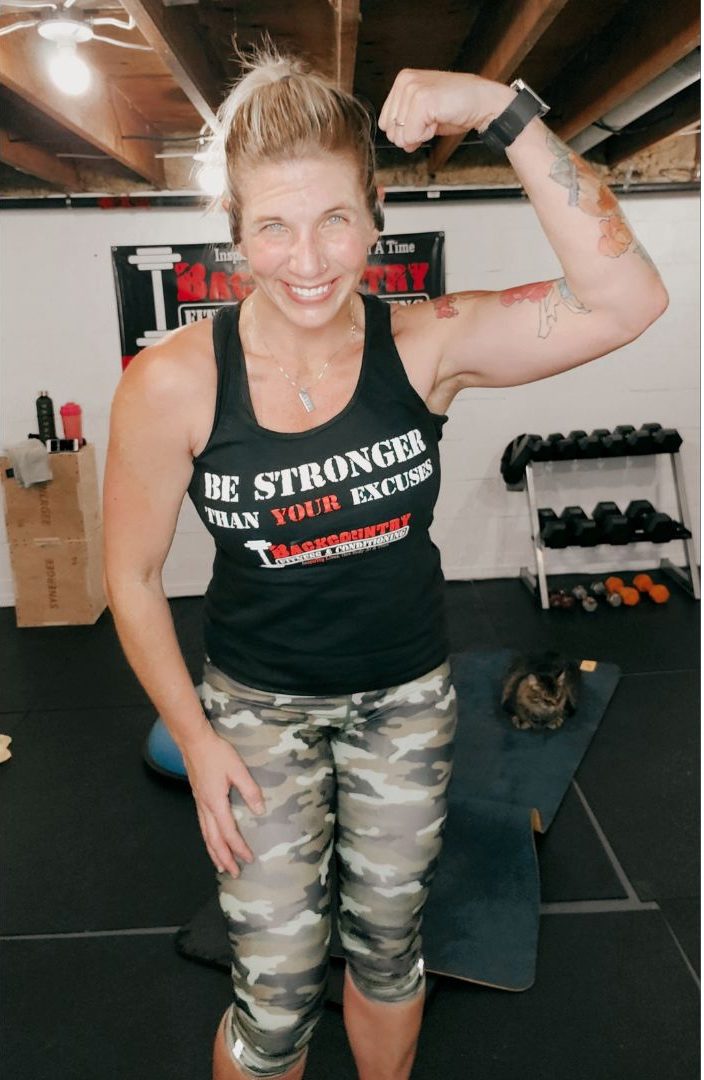
Ms. Namita Nayyar:
How have you modified your diet & lifestyle routine to overcome these challenges and stay healthy & fit?
Ms. Christina Hooper:
My focus is to educate myself on this illness and find out the triggers of inflammation on the damaged nerves.
Cutting out gluten and dairy products from my daily intake has been the primary focus on getting the inflammation in the lesions down. Also, focus on my gut health and consume plant-based foods along with incorporating fermented and prebiotic items to heal my body.
As far as my lifestyle routine, I have been working on achieving small goals as I face the day. Heading out for a walk, working on strength training and functional fitness, resting accordingly, and staying thankful and strong in my faith is crucial in this journey.
And the most important thing?
Mindset is everything.

Ms. Namita Nayyar:
Your daily fitness routine would include? How significant is strength training for women?
Ms. Christina Hooper:
My goal each day is to create a balanced routine. Some days or weeks may look different from others depending on if my symptoms progress. My daily routine usually begins with stretching and prayer. 3 – 4 days per week, my focus is to incorporate 30 – 45 minutes of exercise that can look different each time.
My focus since my diagnosis is not to dwell on what types of workouts I used to design but make modifications to accommodate my level of function as I go. For example, I have been an active runner for my whole life, and for the last couple of months, I have moved to lower-impact aerobic activities such as walking and snowshoeing in the winter months.
Since I am dealing with symptoms of numbness and tingling sensations in my hands, it makes it difficult to hold heavy Dumbbells. So using resistance bands has been a great experience to still incorporate low-bearing resistance training.
I have also changed my aerobic training to low-impact options due to my balance and coordination issues.
My strength training routine is currently focusing on modified exercises, that are low impact and the focus is on endurance, balance, and stability. Strength training is extremely important for women. As we age, our muscles will actually lose density after the age of 35. Sarcopenia, which is defined as age-related muscle loss—can begin at around age 35 and occurs at a rate of 1-2 percent a year for the typical person. After age 60, it can accelerate to 3 percent a year. The loss may be mild, moderate, or severe or muscles can remain in the normal range.
Weight training not only strengthens muscles but also increases bone density. This reduces the risk of fractures and broken bones. It also builds stronger connective tissues and increases joint stability which, as a result, helps prevent injury.

Ms. Namita Nayyar:
5 Exercises appropriate for women suffering from Multiple sclerosis? Things to avoid and watch out for?
Ms. Christina Hooper:
When it comes to workouts, fighting through the exhaustion of MS fatigue is no easy task. I am often asked how fatigue affects my training and how others with multiple sclerosis (MS) can get great workouts despite this common problem.
I wish there were a one-size-fits-all answer to this question, but since we all have different MS symptoms and limitations related to our MS, and we’re all in different places in life’s journey, I will do my best to give you some general guidelines and suggestions to help you maintain a regular exercise program.
Exercises that I have been focusing on are low-impact exercises such as walking or cycling. Keeping your workouts short such as doing a Tabata Style workout, so that you are able to go for shorter periods of time and still benefit from the rest and recovery in between.
Using resistance bands to still continue your strength training is a great idea for women who are dealing with symptoms of numbness and tingling and electrical currents in their limbs, so they won’t have to risk their safety by dropping a Dumbbell or struggling to hold them in your hands.
When considering how your workouts will look, you will need to evaluate how you are feeling, how your body responds, and most importantly how you feel after a workout.
There may be an adjustment period where you are trying to understand the struggles that your body is experiencing, so this may be a trial period for you.
If you are dealing with imbalance, stability, and balance issues, try to limit your movements to stationary and low-impact options. Avoid quick movements that could cause you to trip or fall.
Be mindful of strenuous workouts as putting your body under too much stress can result in a negative impact, and can cause symptoms to flare.
3 important tips to focus on:
1.) Set up a consistent workout schedule.
With many of the challenges we face with this disease, the ability to control your workout and your mind is a game changer.
2.) Listen to your body. Work out for no more than 45-60 minutes at a time. Unfortunately, the fatigue that comes from Multiple sclerosis can be extremely difficult, so setting some limitations related to our workouts is important; to prevent any more added stress to your body.
3.) Find a supportive network and community to join. When you are surrounded by like-minded people, the support of others will help keep your morale up and keep you encouraged. Find your tribe and you will be unstoppable.
Ms. Namita Nayyar:
Significance of mental health?
Ms. Christina Hooper:
This one should be your number one priority. The level of your mental health will dictate your day-to-day activities.
Your mental health is everything, prioritize it. It is important because it will help you cope with the stress of life, be physically healthy, have good relationships, and realize your full potential.
Mental health I just as important as physical health. Remember that.
Disclaimer
The Content is not intended to be a substitute for professional medical advice, diagnosis, or treatment. Always seek the advice of your physician or other qualified health provider with any questions you may have regarding a medical condition.